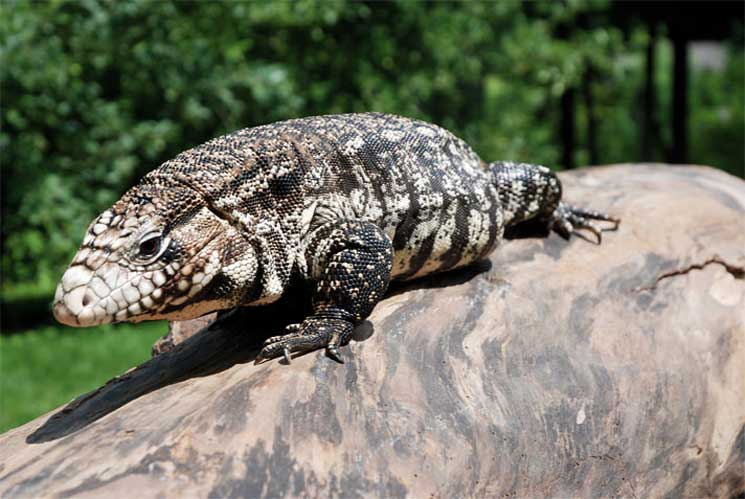How to provide the best care for the intelligent and engaging Argentine tegu.
When I was a young girl walking to and from school in Toronto, I would bring home all the wounded snakes I found. I’d doctor their wounds, put them in a shoebox and keep them warm—then Mom would find them and out the door they went.
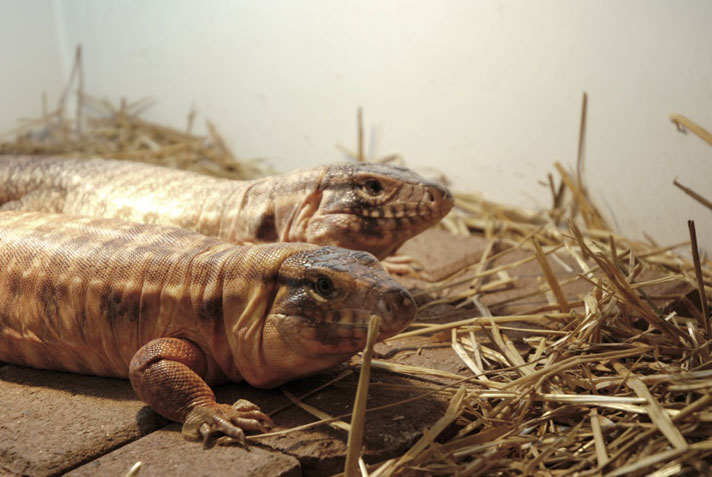
CINDY TROOST-MASSOLIN
To own an Argentine tegu is to have an intelligent friend with scales take hold of your heart and become a true member of your family.
Now that I’m grown, that passion for reptiles is stronger than ever, and it is deeply seeded in my love of Argentine tegus. In my lifetime, I have owned many different reptiles, but nothing compares to an Argentine tegu. To own an Argentine tegu is to have an intelligent friend with scales take hold of your heart and become a true member of your family. It’s a reptile that looks at you when you talk to it, is curious about you and what you’re doing, interacts with you when you take it out of its enclosure, and truly wants to be in your company. If you’re looking for a large, intelligent lizard that craves interaction, then perhaps an Argentine tegu is right for you. However, if you’re looking for a lizard that remains a smaller size, can live in a small tank for its entire life and stays in its enclosure 24/7, then an Argentine tegu is definitely not right for you. These lizards will require time and effort on your part.
Where Tegus Occur in the Wild
In the wild, Argentine tegus are found in Argentina, Paraguay, Uruguay, Brazil, and now in the Miami area of Florida, possibly due in part to people releasing pet tegus into the wild. This kind of release hurts everyone, so please do your homework first before buying a tegu. Make sure this very large lizard is right for you before bringing home a cute little baby from a reptile show. They remain cute, but they don’t remain little.
Wild Argentine tegus live in meadows of pampas grass. Their day consists of waking up, walking to a basking spot, heating up and then hunting for food. They’re back for some more basking to help digest their meal, and then they retreat to their burrow, dug in the ground, to cool down and sleep for the night.
The Tegu is a Large Lizard
Argentine tegus are large, strong, intelligent lizards that can grow upward of 5 feet long and weigh more than 20 pounds. An average female is around 3 to 3½ feet long and 6- to 8-plus pounds. An average male is about 4 to 4½ feet long and 8- to 12-plus pounds. There are always exceptions to the rule, however, including tegus that are smaller and larger than the average.

Cindy Troost-Massolin
Always support your tegu from its body and never pick it up by the tail.
Given that tegus are ground-dwelling lizards, keeping an adult happy indoors requires a large footprint, but not a lot of height. An enclosure measuring 3 feet tall, 3 feet wide and 8 feet long would be the minimum size needed for a subadult or adult, but an enclosure measuring 3 feet tall, 4 feet wide and 8 feet long would be ideal. For a hatchling or yearling, skip the small aquarium. You will need an enclosure that is at least 2 feet tall, 2 feet wide and 4 feet long, with sliding doors on the front and a screen/solid top. If you can cover three-fourths of the screen top, or if you can find a lid that is solid for three-fourths of the top and a screen for the rest (at one end), this will help hold your temperatures steady and maintain humidity.
We build our large, indoor enclosures to be 3 feet tall, 3 feet wide and 8 feet long, and use half-inch, double-sided melamine for the walls and top and three-quarter inch for the floor. White bathtub caulking is used to seal the seams, and we use acrylic for the sliding doors, for both safety and durability. To make cleaning easier, we prefer three smaller doors over two larger ones, with a thumb hole measuring approximately 28 mm in diameter, drilled 3 inches down and 3 inches in from the top corners of each piece.
Climate Control for Your Tegu
Your tegu needs one end of the enclosure to be hot and the other to be cool. In our adult enclosures, we build a brick patio measuring 3 feet wide and 3 feet long for the basking area. The bricks retain heat after the lights turn off, file sharp points off the tegus' nails, and can be removed—one brick at a time—for spot cleaning rather than struggling with a large, soiled rock. Above the bricks, we install an expandable closet hanger rod and hang a large reptile light fixture. We use a 160-watt mercury vapor bulb (MVB), as it provides both the heat and UVB that a tegu needs. For smaller hatchlings and yearlings, we use a 100-watt MVB.
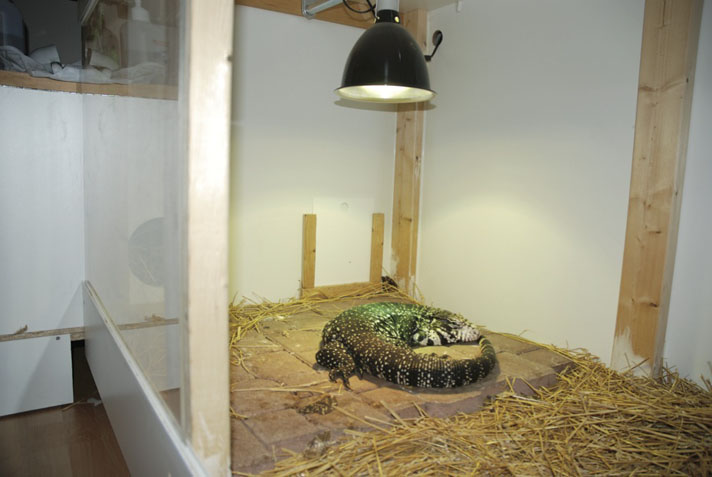
CINDY TROOST-MASSOLIN
The ambient temperature at the basking end should be 85 to 95 degrees; the cool end should be 75 to 85 degrees and the nighttime temperature when the lights are turned off should be around 70 degrees.
The basking spot temperature for hatchlings and adults should be 95 to 105 degrees Fahrenheit, when taking a reading approximately 2 to 4 inches above the bricks, directly below the MVB. The ambient temperature at the basking end should be 85 to 95 degrees; the cool end should be 75 to 85 degrees and the nighttime temperature when the lights are turned off should be around 70 degrees.
If you use a reptile light and a separate UVB bulb instead of a MVB, be sure to use a 26-watt, 10.0 compact desert UVB lamp to provide full-spectrum UV lighting. Along with shedding problems, a lack of calcium absorption (nutritional secondary hyperparathyroidism) is a common problem in lizards kept indoors, including tegus, hence the need for UVB lighting. Be certain to arrange all lights so that your tegu cannot burn itself! We recommend a 12 hour on/off schedule for the lighting during their active season and allowing them to hibernate (something they would do naturally, in the wild) over the winter.
What Substrate is Recommended for Tegus?
In the middle of the adult enclosure, we place a 6-inch-deep layer of wheat straw. Wheat straw is inexpensive, easy to come by, less dusty than other substrates and easy to spot clean. You can also use coco husk (we use this with younger tegus), pure cypress mulch, aspen shavings, orchid bark, Eco Earth, Repti Bark and eucalyptus, but some can be hard to find and others can be pricey. Do not use pine or cedar mulches—they are toxic to reptiles. Mist the substrate regularly to help with humidity, but don’t soak it.
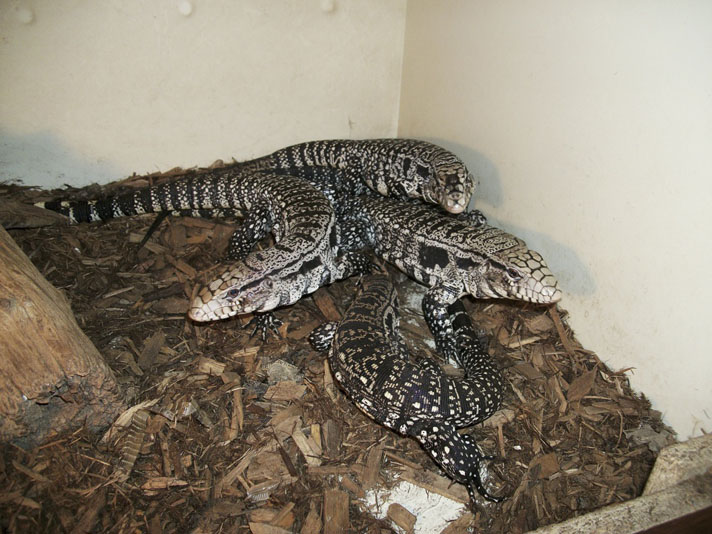
CINDY TROOST-MASSOLIN
Wheat straw is inexpensive, easy to come by, less dusty than other substrates and easy to spot clean. You can also use coco husk (we use this with younger tegus), pure cypress mulch, aspen shavings, orchid bark, Eco Earth, Repti Bark and eucalyptus.
It is more difficult to maintain humidity in a large enclosure than a small one, but you can maintain proper humidity levels by misting the side walls of the enclosure daily. Another option is to purchase a mister/fogger to help with the humidity. A moist hide box, too, is an absolute must for an indoor tegu.
Provide Hides For Tegus
At the cool end of the enclosure, place a clear plastic tote with a lid, measuring approximately 14 inches tall, 19 inches wide and 32 inches long, to serve as a subadult/adult hide box. For a hatchling hide, the tote can measure 6 inches tall, 11 inches wide and 16 inches long, and 6 to 8 inches tall, 16 inches wide, and 23 inches long for a yearling.
Fill the hide box three-quarters full with a mix of 65 percent small-chip coco husk and 35 percent sphagnum moss (pre-moisten the moss, but do not make it sopping wet). Put the lid on the tote, and cut a circular hole toward one end of the lid, approximately 1 to 2 inches wider than your tegu. You may need to enlarge the hole as your tegu grows.
If your tegu has trouble climbing up onto the hide box, use a brick or two to provide a step up, and to provide traction, attach adhesive, non-slip strips (like the kind used on boats) to the lid and the front of the hide box, below where the hole is located. If you think your tegu would prefer a darker hide, cover the clear tote with a dark adhesive vinyl shelf liner, or use a tote constructed of darker-colored plastic.
Keep the humidity up in the hide box by occasionally misting it with clean water. It should be damp, not wet. A tegu naturally spends about 60 percent of its time (nights, winter hibernation, etc.) inside its burrow (hide box) and relies on it to be humid inside. Good shedding and a healthy animal—complete with all of its toes and tail—depend on it.
From time to time, your tegu may experience shedding difficulties, especially on tails and toes. If so, slather Vaseline Intensive Care lotion with vitamin E on the stuck shed several times a day for three days. On the fourth day, gently rub the stuck shed, and it should roll off. Repeat if required.
If you plan to winter hibernate your tegu, replace the hide box medium right before hibernation, as the hide box will serve as your tegu's hibernation burrow.
What Should I Feed a Tegu?
Wild tegus are opportunistic and will eat anything they can fit in their mouths: ground-nesting birds and their eggs, a nest of baby mice, smaller snakes and lizards, frogs, toads, fruits and veggies.
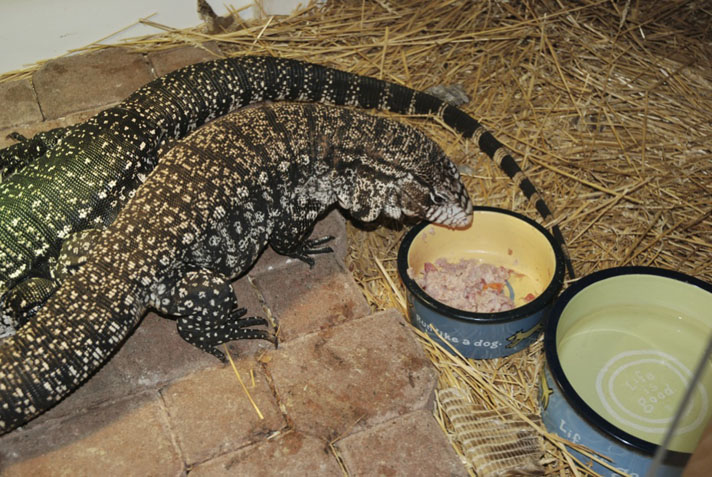
Cindy Troost-Massolin
The author uses heavy ceramic food and water bowls to prevent tegus from tipping them over and ingesting substrate.
A varied diet should be offered for proper nutrition. For hatchlings, a 4:1 ratio of protein to fruit/veggies works well. For yearlings it could be 3:1, and a subadult/adult tegu's ratio could be about 2:1.
Protein sources can be ground turkey, chicken, fresh fish, beef liver, chicken giblets, frozen-thawed pinkies/fuzzies/mice (once a week, size-appropriate), crickets, mealworms, superworms, butterworms, silkworms, tomato hornworms (dusted with calcium) and eggs (boiled or scrambled).
What Not to Feed Your Tegu
- Don’t feed onions (or things cooked with onions), mushrooms or avocados. This can cause serious health risks in other animals, so exercise caution.
- Given that tegus will eat all sorts of food, obesity can occur. Don’t overfeed or offer foods that wouldn’t be good for you or your tegu.
- If you’re not a bug person, you can raise a healthy, happy tegu bug-free by including other kinds of protein in your tegu's diet.
- Tegu diet ratios change slightly with age, but the basics remain the same.
- Feeding amounts should start with small, bite-size portions and increased as necessary. Your tegu will tell you when it’s full. If it eats all of its food, offer more and remember to increase the amount you regularly feed your pet. Likewise, if it regularly leaves food, decrease the amount being offered.
Fruit can include grapes, strawberries, blueberries, melon, blackberries, peaches, nectarines, mango and bananas (sparingly). Vegetables that are good choices include cauliflower, tomatoes, green beans and peas.
Want To Learn More?
Build The Perfect Indoor Tegu Enclosure
Feeding vegetables and fruits that are high in beta carotenes will help with shedding and skin in general. These include sweet potato, winter squash, pumpkin, carrot, Goji berry, cantaloupe, mango, apricot, spinach (feed sparingly—perhaps once a month), and greens such as kale, chard, turnip, dandelion, mustard, collard, watercress, beet greens, cilantro, fresh thyme, broccoli, parsley, romaine lettuce, ivy gourd, rose hips and cassava.
Your tegu will reveal what it prefers, but train your pet to eat a varied diet! We make a “tegu meatloaf” consisting of ground chicken and turkey, and a selection of fresh or frozen-thawed fruits and veggies. We add calcium with D3 every third or fourth feeding, as well as a good-quality herp multivitamin. We mix the ingredients to the consistency of meatloaf before dividing the mixture into bite-size pieces that we place in our tegus' bowls along with an extra bit of a preferred fruit and/or vegetable. This method will get your tegus eating everything you want them to eat, rather than only the foods they want. The meat/fruit/veggies mixture, minus the calcium and vitamins, can be frozen in ice cube trays. Pop cubes out into a freezer bag to store, and take out and thaw overnight only what you will offer your tegu the next day. Mash up the thawed cubes and offer as described above.
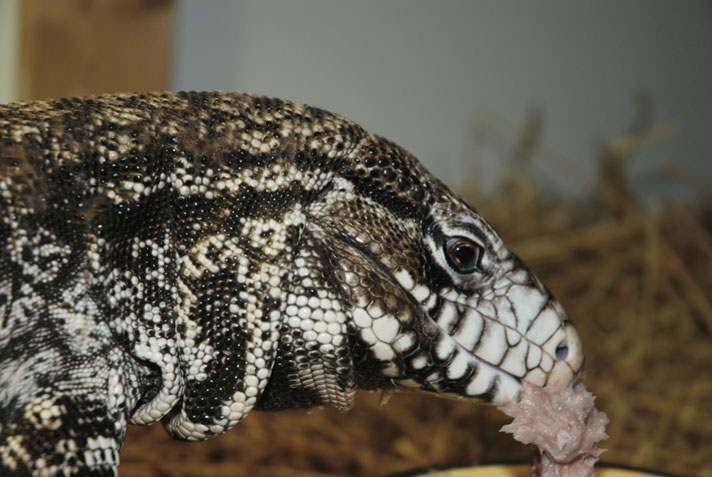
CINDY TROOST-MASSOLIN
A varied diet is required for your tegu to benefit from a wide range of nutrients.
There is debate about whether or not to feed tegus in a separate enclosure. We don’t because we believe this trains them to expect food every time they’re picked up. We want our tegus to learn that we are picking them up for interaction, not for food. Instead, for hatchlings and yearlings, we place food and water bowls on top of the hide box. Cleaning its lid each morning and setting the bowls there gives our tegus a clean place to eat their food and keeps them from ingesting substrate. We place bowls for the sub-adults/adults on the bricks (away from the light), and their larger water bowls on the straw.
Tegus require fresh water and a clean water bowl daily. If your tegu likes to soak in its water bowl, place a cat litter pan (clean, without the lid/hood) filled with water into the enclosure for both drinking and bathing. It needs to be cleaned at least daily, or more often if your tegu defecates in the pan.
Tegu Hibernation Tips
If you plan to hibernate your tegu, stop feeding it when it’s eating has slowed, usually mid-October. Keep the lights on for the next 14 days, but don’t feed the tegu anything. Continue to provide fresh water. Every five days, give your tegu a warm soak to help clear its system of fecal waste. During these 14 days, slowly lower the temperature in the tegu room (we open the window about an inch).
On day 15, turn the lights off and leave your tegu to go into hibernation naturally. Measure the temperature in the tegu room continuously from this point onward. Hibernation temperatures should remain at 55 to 65 degrees Fahrenheit. Don’t forget to monitor the moisture inside the hide box, which needs to remain slightly damp.
In the spring, usually sometime in mid-March or mid-April, your tegu will come out of its hide box. When you see it in its basking area, turn the lights on for about an hour. If the tegu remains out the next day, leave the lights on for two hours, gradually increasing the duration each day until they're back on the 12/12 on/off schedule.
Do not feed your tegu right away. After one week, begin offering small pieces of its favorite fruit. After two weeks, add small amounts of meat and vegetables to its meals. By the third or fourth week, your tegu should be eating normally; however, some tegus may take an additional week or two to get back to normal eating.
How to Tame a Tegu
A tegu’s eyes should be large and bright. They can tell you if a tegu is healthy or sick, happy or angry, hungry, scared or content—all with their eyes.
In the beginning, a new tegu may be a bit frightened of you and its new surroundings. By not handling your new pet for the first few days, but while still putting your hands in and out of the enclosure while tending to its food and water, you’ll start gaining your tegu’s trust. Trust is the key. As your tegu begins to trust you, you’ll notice a change in its eyes if you pay close attention. You may then learn to determine how your tegu is feeling by whether its eyes appear calm or wide-eyed and panicked.
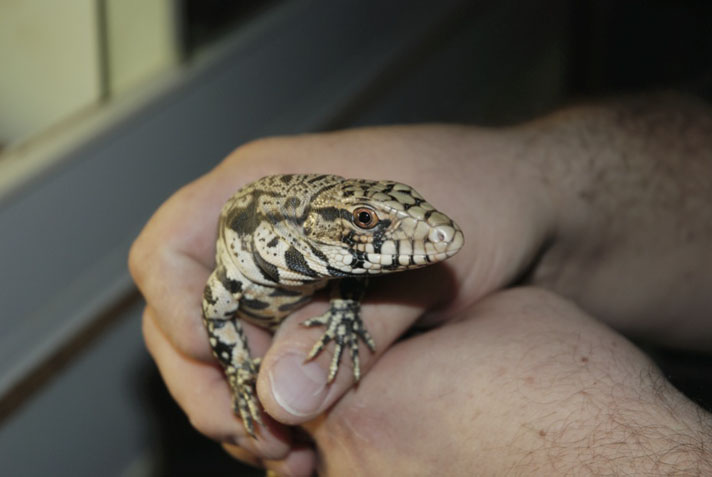
Cindy Troost-Massolin
Hold your tegu firmly, but not too tight. You do not want the lizard to feel threatened.
After the first few days, you can start handling your tegu, gently but firmly, so that it doesn't fall or escape from your hands. Continue to hold your tegu, even if it is wriggling and trying to escape. Once it calms a bit, stroke the back of its head and talk to it in a soft voice. Once it's completely calm, wait another couple of minutes before placing your tegu back inside its enclosure. Your tegu should then learn that it needs to be calm in order to be placed back into its enclosure. Otherwise you teach the tegu that if it goes crazy in your hands, you’ll leave it alone. Eventually you will gain your tegu’s complete trust, and your tegu will likely seek your companionship and want to be with you more than it wants to be in its enclosure.
Tegus, just like people, have different personalities. I have a shy red tegu that wants to sit on my head whenever it is out. I have a black and white tegu that I rescued when he weighed just 1 pound, that is now a snuggle-bunny. He tucks his head under my chin and nuzzles my neck while the rest of his body hangs down the front of me. If I let him, he would stay there until the end of time. I’ve had him for two years, and he now weighs in at just less than 10 pounds. I don’t have any way of knowing if the near starvation stunted his growth. What I do know is that he knows I am the one who saved him from such a bad situation. His eyes light up when I come near his enclosure.
If you decide to get a tegu, be prepared to dedicate the effort and time needed to care for it. On average, tegus live between 12 and 15 years, but they can live as long as 20. These intelligent lizards need interaction and a large enclosure. Make sure you can meet their needs before bringing one home.
Cindy Troost-Massolin owns and operates Tegu Topia (www.TeguTopia.ca), located in Central Ontario, Canada. Her Argentine tegu collection includes tegus from Bert Langerwerf and, through her friendship and mentorship with Johnny LaRocca, Tegu Terra. Tegu Topia should have some very interesting tegus available in both Canada and the U.S. in the coming years, due to a new breeding partnership with Tegu Terra (USA).

